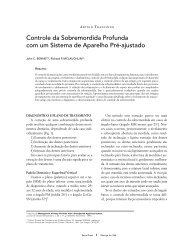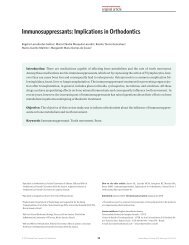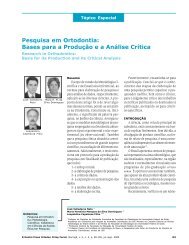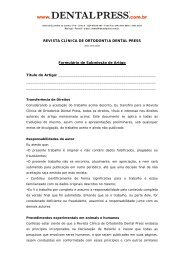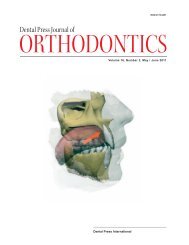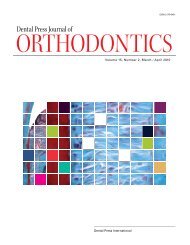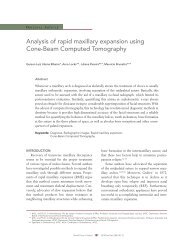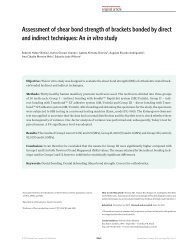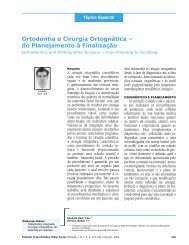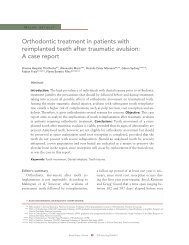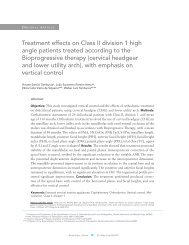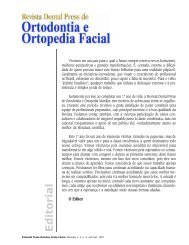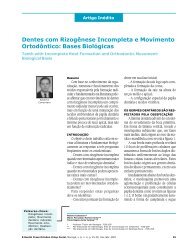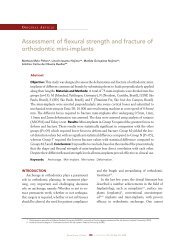Dental Press
Dental Press
Dental Press
Create successful ePaper yourself
Turn your PDF publications into a flip-book with our unique Google optimized e-Paper software.
[ original article ] In vitro determination of direct antimicrobial effect of calcium hydroxide associated with different substances against Enterococcus faecalis strainsIt is important to emphasize that the pH of calciumhydroxide pastes is generally higher than 11, and thatthe addition of several substances does not alter thesevalues. 25,26 However, within the dentin tubules, the pHmight not reach such high levels, 27,28 hence the suggestedassociation of different substances to the pasteswith the goal of enhancing the antimicrobial action, withpositive results. 9In this paper, Ca(OH) 2pastes in three different vehiclesdemonstrated great effectiveness against all E.faecalis strains after direct in vitro contact of the microorganismwith the paste. The addition of guaçatongadid not interfere with the antimicrobial action of calciumhydroxide, confirming that the presence of thissubstance did not alter the pH of the paste. Furtherexperiments should be carried out in order to demonstrate,both in vivo and in vitro (using extracted teeth)whether similar effect is observed. It is important totake into consideration that for calcium hydroxide tomaintain its ability to raise the pH within the dentintubules, the hydroxyl ions should diffuse throughoutdentin in high enough concentrations to exert buffereffect and consequently induce a drastic increase inthe local pH values.The guaçatonga essential oil has shown effective actionagainst Gram-positive bacteria such as Enterococcus,Micrococcus, Staphylococcus aureus, S. epidermidis 14 andBacillus cereus strains. 29Methods in which the pastes are diffused on the agarsurface, as described by Gomes et al, 15 or those involvingdirect contact with the paste, followed in the present workand others, 21 are susceptible to interference from severalvariables, namely differences in solubility and diffusion ofthe paste in the medium, the inoculum, pH of the agarcomponents, agar viscosity, incubation times and temperature,and metabolic activity of the microorganism inthe culture medium. All of these factors hinder the extrapolationof the results to a clinical setting, where other differentfactors may interfere with the antimicrobial actionof the paste against microorganisms in the dentin tubules.Therefore, it is unquestionable that future studies areneeded in order to determine whether guaçatonga extractin propylene glycol is able to enhance the efficacy of calciumhydroxide pastes against E. faecalis in extracted teethin vitro or in vivo, in actual clinical conditions. The discoveryof antimicrobial biocomponents derived from this plant,with activity against bacteria found in the oral microbiota,may lead to new therapeutic alternatives in Dentistry.References1. Koneman EW, Allen SD, Janda WM, Schreckenberger PC, Winn-Júnior WC. Diagnóstico microbiológico: texto e atlas colorido. 6ª ed.Rio de Janeiro: Guanabara Koogan; 2008.2. Kayaoglu G, Ørstavik D. Virulence factors of Enterococcus faecalis:relationship to endodontic disease. Crit Rev Oral Biol Med.2004;15:308-20.3. Murray PR, Rosenthal KS, Pfaller MA. Microbiologia médica. 5ª ed.Rio de Janeiro: Elsevier; 2006.4. Sundqvist G, Figdor D, Persson S, Sjögren U. Microbiologic analysisof teeth with failed endodontic treatment and the outcome ofconservative retreatment. Oral Surg Oral Med Oral Pathol Oral RadiolEndod. 1998;85(1):85-93.5. Pinheiro ET, Gomes BPFA, Ferraz CCR, Sousa ELR, Teixeira FB,Souza FJ Filho. Microorganisms from canals of root-filled teeth withperiapical lesions. Int Endod J. 2003;36(1):1-11.6. Röças IN, Siqueira JF Jr, Santos KRN. Association of Enterococcusfaecalis with different forms of periradicular diseases. J Endod.2004;30(5):315-20.7. Evans M, Davies JK, Sundqvist G, Figdor D. Mechanism involvedin the resistance of Enterococcus faecalis to calcium hydroxide. IntEndod J. 2002;35(3):221-8.8. Cháves de Paz LE, Bergenholtz G, Dáhlen G, Svensäter G.Response to alkaline stress by root canal bacteria in biofilms. IntEndod J. 2007;4(5):344-55.9. Evans MD, Baumgartner JC, Khemaleelakul S, Xia T. Efficacy ofcalcium hydroxide: chlorhexidine paste as an intracanal medication inbovine dentin. J Endod. 2003;29(5):338-9.10. Barbin LE, Saquy PC, Guedes DFC, Sousa-Neto MD, Estrela C,Pecora JD. Determination of para-chloroaniline and reactive oxygenspecies in chlorhexidine and chlorhexidine associated with calciumhydroxide. J Endod. 2008;34(12):1508-14.11. Teske M, Tentini AMM. Compêndio de fitoterapia. 4ª ed. Curitiba:Herbarium; 2001.12. Lorenzi H. Árvores brasileiras: manual de identificação e cultivo deplantas arbóreas nativas do Brasil. Nova Odessa: Plantarum; 1992.13. Esteves I, Souza IR, Rodrigues M, Cardoso LG, Santos LS, SertieJA, et al. Gastric antiulcer and anti-inflammatory activities of theessential oil from Casearia sylvestris Sw. J Ethnopharmacol.2005;101(1-3):191-6.14. Schneider NFZ, Moura NF, Colpo T, Flach A. Composição química eatividade antimicrobiana do óleo volátil de Casearia sylvestris Swart.Rev Bras Farm. 2006;87:112-14.15. Gomes BPFA, Ferraz CCR, Garrido FD, Rosalen PL, Zaia AA,Teixeira FB, et al. Microbial susceptibility to calcium hydroxide pastesand their vehicles. J Endod. 2002;28(11) 758-61.16. Cwikla SJ, Bélanger M, Guiguére S, Progulske-Fox A, VertucciFJ. Dentinal tubule disinfection using three calcium hydroxideformulations. J Endod. 2005;31:50-2.© 2011 <strong>Dental</strong> <strong>Press</strong> Endodontics 50<strong>Dental</strong> <strong>Press</strong> Endod. 2011 apr-june;1(1):46-51



